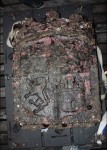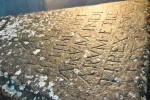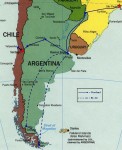 Divers have discovered a Spanish shipwreck from 1583 off the coast of Brazil’s southern Santa Catarina state. Although they haven’t found any remains including the name of the ship, they did find a triangular plaque engraved with the date 1582 and King Philip II of Spain’s name. They also discovered a stone shield bearing the heraldic symbol of the Iberian Union, the dynastic union of the monarchies of Spain and Portugal that united the entire Iberian peninsula south of the Pyrenees under a single crown (the Spanish one).
Divers have discovered a Spanish shipwreck from 1583 off the coast of Brazil’s southern Santa Catarina state. Although they haven’t found any remains including the name of the ship, they did find a triangular plaque engraved with the date 1582 and King Philip II of Spain’s name. They also discovered a stone shield bearing the heraldic symbol of the Iberian Union, the dynastic union of the monarchies of Spain and Portugal that united the entire Iberian peninsula south of the Pyrenees under a single crown (the Spanish one).
 Archaeologists believe that the triangular plaque would have been used as a marker to claim any newly discovered lands. The Iberian Union was established in 1580. Contemporary documents reference a ship going down on January 7, 1583 off the coast of Santa Catarina, so even without the ship name there is solid evidence that the wreck dates to the early 1580s. If the 1583 date is confirmed, this will be the oldest shipwreck ever found in Brazil.
Archaeologists believe that the triangular plaque would have been used as a marker to claim any newly discovered lands. The Iberian Union was established in 1580. Contemporary documents reference a ship going down on January 7, 1583 off the coast of Santa Catarina, so even without the ship name there is solid evidence that the wreck dates to the early 1580s. If the 1583 date is confirmed, this will be the oldest shipwreck ever found in Brazil.
The recovered pieces and the documentary review indicate the wreck was a supply ship for a fleet that left Spain in 1581 on a mission to build two forts on the Strait of Magellan to stymie the advance of English pirates menacing Madrid’s territories in the New World.
Starting March 14th, divers will return to the site to bring back as many artifacts as they can find, visibility and currents depending. On previous dives they saw a cannon, ballast stones, cannonballs and ceramic fragments which the team hopes to recover on the upcoming underwater expedition.
The Portuguese had landed on the Island of Santa Catarina, the island which today contains most of state capital Florianópolis, in 1514, but they didn’t colonize it until the next century. It was Spain who first began to use it as a base for trade and further exploration just a decade later.
 In 1525, Charles I of Spain ordered the friar García Jofre de Loaísa to take a fleet of seven ships and 450 men, sailors plus tradesmen and clerical staff, westward to reach the far east. The expedition’s immodest brief was to cross the Atlantic Ocean, the Strait of Magellan and the Pacific Ocean to reach the Spice Islands (today part of Indonesia). Don Rodrigo de Acuña, captain of the fourth ship, stopped at Santa Catarina Island and left 17 of his crew behind before continuing on towards the Strait.
In 1525, Charles I of Spain ordered the friar García Jofre de Loaísa to take a fleet of seven ships and 450 men, sailors plus tradesmen and clerical staff, westward to reach the far east. The expedition’s immodest brief was to cross the Atlantic Ocean, the Strait of Magellan and the Pacific Ocean to reach the Spice Islands (today part of Indonesia). Don Rodrigo de Acuña, captain of the fourth ship, stopped at Santa Catarina Island and left 17 of his crew behind before continuing on towards the Strait.
I don’t know what their fate was, but it can’t have gone much worse than the Loaísa expedition which shed ships and people like a husky sheds undercoat in the summer. Only four ships reached the Pacific, and only one, the Santa Maria de Parral, reached the Spice Islands in 1526 carrying the captain, Andrés de Urdaneta, and 24 of his men. They were captured by the Portuguese for their trouble but eventually made it back to Spain in 1528, thus completing the second circumnavigation of the globe in history.
The first permanent European settlement on Santa Catarina Island was established by Spanish colonists in 1542. The island was used as a supply port by Spanish ships headed towards the Rio de la Plata estuary that today lies on the border between Uruguay and Argentina. The Portuguese took over in 1673, gradually colonizing the island and the mainland coastline. By the late 1670s, the settlement that would become Florianópolis was beginning to grow.